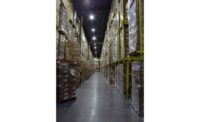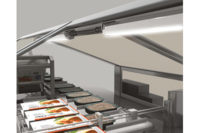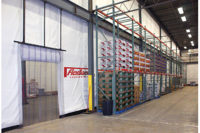Experts say that energy-efficient doors and curtains can pretty much pay for themselves in just a few years. With the energy reductions, cost savings and improved worker safety, today’s offerings feature nothing short of putting money back into the bottom line.
Doors with more
Eliason Corp., Kalamazoo, Mich., for instance, introduced a new line of swing and sliding walk-in cooler/freezer doors—the CD-4000, CD-6000 and FD-6000.
“Our doors are superior to other cooler and freezer doors because they are made entirely of composite, fiberglass-reinforced plastic (FRP) materials, meaning they are unaffected by moisture and will not rot or warp,” says Rick Proskow, marketing manager. “Our unique construction creates an extremely rigid, durable door, which is NSF-certified (swing model) and offers insulating values from R-28 to R-42, depending on the model ordered. These doors have several casing mounting options, which make them ideal for retrofit, remodel or replacement installations.”
Eliason also offers the FLT-400 flexible door, which is a traffic door suited for low-temperature environments (down to -30°F). With jamb edge balloon seals, wiper gaskets and frame-mounted top seals, it is made of USDA-accepted belting material, and is ideal as a primary traffic door in food processing frozen or cooler areas.
Cold Chain, LLC, Boise, Idaho, developed advanced networking capabilities that allow its doors to be remotely monitored and secured with maintenance monitoring and alerts.
“In addition, we have added a line of energy-efficient dock doors that work very well not only in refrigerated spaces, but [also] in ambient dock areas,” says Michael Shaughnessy, president. “These impactable dock doors eliminate forklift damage while providing a significantly better barrier between exterior and interior temperatures.”
Cold Chain also designed new patent-pending infiltration reduction technology that eliminates nearly all infiltration at conveyor openings and forklift doors.
“The infiltration reduction vestibule system (IRV) eliminates the pressure differential between the warm high-pressure air and the refrigerated low-pressure space,” says Shaughnessy. “The system reduces infiltration by up to 95% and qualifies for significant energy savings rebates offered by utility providers.”
Barriers with speed
The Serco Thermal Guard Package from Serco Co., Carrollton, Texas, is said to provide the ultimate energy and security seal for climate-controlled loading docks, allowing truck doors to be opened from inside the building after the truck is positioned at the door without breaking a thermal seal at the dock. The Thermal Guard Package includes an enhanced hinged bottom draft pad, bumper covers and extended bumper gussets (to work with 10-foot wide doors) to provide greater sealing capability.
Meanwhile, Frommelt Safety, Milwaukee, Wis., updated its automated barrier door—the Guardian Defender—to protect employees from automated stretch-wrap machines and other robotic machine movement zones. The new door safely separates machine operators from manufacturing processes, and features a roll-up design for minimal footprint. The PLe hold-down mechanism locks the door “down” in position to allow for machine “de-energizing” time. Plus, the redesigned rotary cam limit switch and encoder positions control the curtain’s operating speed and position.
Also controlling doors’ speed is Mars Air Systems. In fact, the Gardena, Calif., door manufacturer added features to its air curtains to enhance their use in refrigeration and cold storage applications.
“One such feature is motor speed controllers,” says Steve Rosol, president and CEO of Mars Air Systems. “Motor speed controllers allow an air curtain’s output air flow to be adjusted in the field. The ‘right amount’ of air flow is required in order for the air curtain to be effective. Too little air flow causes the air curtain to have inadequate door opening coverage, while too much air flow can cause a mixing effect between the cold storage room air and the air outside it.”
Recent product introductions from Rytec High Performance Doors, Jackson, Wis., surround end-user safety and maintenance in its coolers and freezers. For example, the new PredaFlex option for the PredaDoor eliminates entrapment concerns and provides additional impact protection without sacrificing door stability and sealing performance, says Kurt Angermeier, vice president of marketing.
“Automation, advancements in conveyor systems, narrower aisles and taller racks are driving the need for new technologies and connectivity in the door industry,” he adds. “Ever-changing food and beverage regulations (i.e. Food Safety Modernization Act and Hazard Analysis and Critical Control Point programs) continue to influence engineering decisions for manufacturing environments.”
Furthermore, TKO Dock Doors, Sussex, Wis., introduced what is said to be the industry’s first and only door specifically designed for vertical storing dock levelers—the Verticool—giving customers the ability to purchase a 4-inch thick door to match the building wall insulation without breaking the bank, says Josh Brown, regional sales manager.
“Door opening construction is critical,” he adds. “When door jambs and headers are not thermally broken, the transfer of heat from the exterior can be a problem, not only with energy loss, but also moisture buildup around the door tracks and dock area. When properly constructed, you reap the energy saving benefits of the entire door system.”
Today’s doors go green
While many of today’s doors and curtains maintain energy-efficient features, they’re also becoming more sustainable.
For instance, the Albanybrands of high-speed doors manufactured by ASSA ABLOY Entrance Systems, Lawrenceville, Ga., are equipped with LEED-certified green features.
“Large buildings and warehouses require a lot of energy, mostly for heating, but much of that energy is often wasted,” says Juan Vargues, president. “All of our doors, especially the AlbanyThermal series of high-speed doors, boast incredibly high opening and closing speeds and have double-seal protection that prevents air leakage and limits air infiltration to reduce energy costs.”
Because cold storage facility doors are subject to wide temperature extremes and hollow metal doors can rust from the inside out, Eliason’s doors are developed to fit each unique application.
“We design our doors to be durable and low maintenance, which reduces cost to the consumer over the lifetime of the door,” says Proskow. “Our primary cooler doors offer high R-value solutions, and our secondary flexible doors can be used to increase the efficiency of an existing facility by improving traffic flow and minimizing air loss and reducing energy use.”
TKO Dock Doors also offers unique sealing capabilities, such as compression seals that can be installed on a number of LEED-certified buildings.
“With rising energy costs, customers and architects have already begun to rethink the thickness of the doors they are purchasing,” says Brown. “Although they cost more upfront, over time they can serve as a good investment.”
It pays to install energy-efficient doors, especially when they pay for themselves.
LED Dock Light Brightens up Loading Docks
Rite-Hite, Milwaukee, introduced a new LED dock light design called the Rite-Lite Flex Neck LEDDock Light. This new light incorporates Flex Neck Technology,which offers enhanced flexibility and adjustability when lighting a trailer or container at the loading dock.
The new Rite-Lite Flex Neck LEDDock Light features a multi-articulating arm made from molded nylon links. The links offer multiple bend points for increased flexibility at the loading dock. The bend points can be easily modified in the field to address unique needs or obstructions that may be encountered at a dock opening. In addition, the links can be tightened, if necessary, to eliminate the sagging that often occurs with traditional metal snake arms.
There are four different settings with visual indicators to clearly identify the current level of lighting, allowing users to select the desired level of light output. In addition, an optional, auto-dimming feature senses when a forklift or person exits a trailer and automatically dims the light to reduce glare.
Hittable Door Technology Delivers More Payback
Jamison Door Co., Hagerstown, Md., created the VersaFlex, specially-designed with every component being a part of the hittable process.
Using Jamison’s unique patent-pending Shearflowtechnology, panels are constructed with internal layers that move independently when struck, sliding relative to one another vs. being constructed as a solid panel. This innovative panel design allows the panel maximum flexibility when hit, and quickly returns to its original form. Plus, the Shearflow design reduces its normal rigidity by 75%, yielding to the impact without damaging the panel or door components.
Making Hanging Strip Doors a Cinch
Chase Doors, Cincinnati, developed Econo MaxQuickStripstrip door curtain systems. Designed for easy installation, the QuickStripallows strips to be installed and replaced easily without the use of tools. Fasten the galvanized strip door bracket to the wall, or hang individual strips to the door bracket. The 8-inch strip material has a 2-inch overlap on each side.










